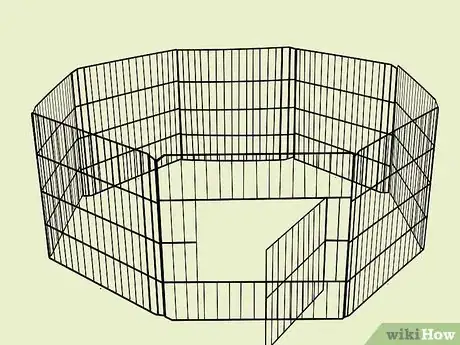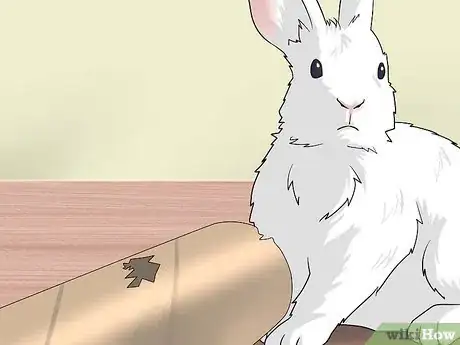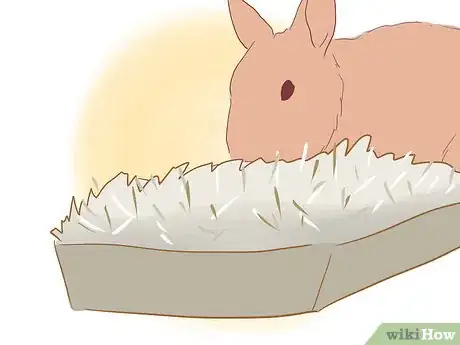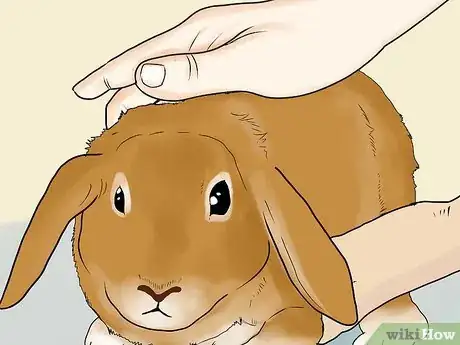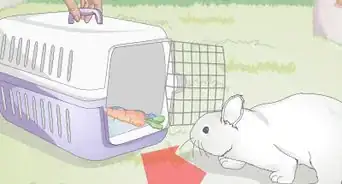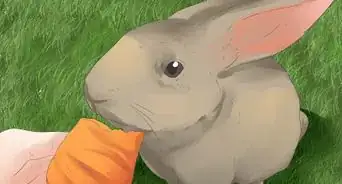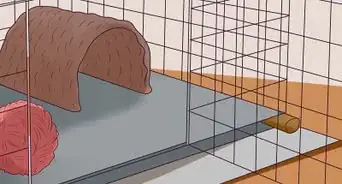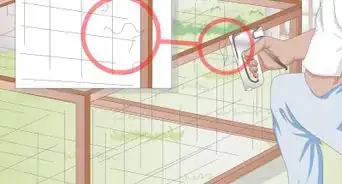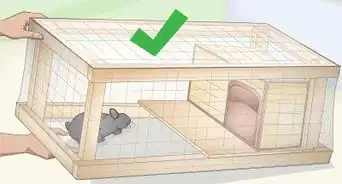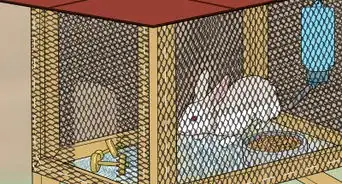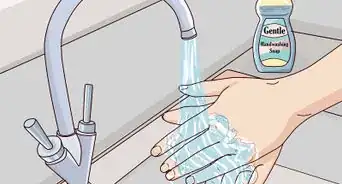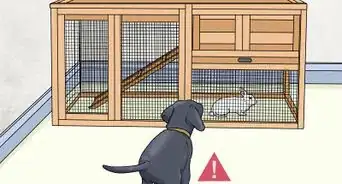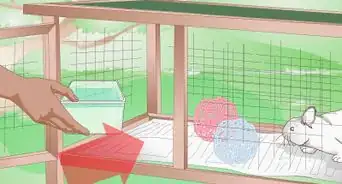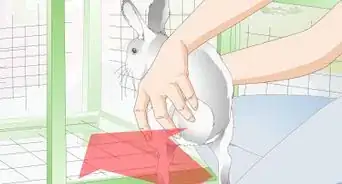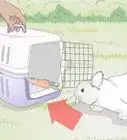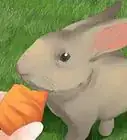This article was co-authored by Pippa Elliott, MRCVS. Dr. Elliott, BVMS, MRCVS is a veterinarian with over 30 years of experience in veterinary surgery and companion animal practice. She graduated from the University of Glasgow in 1987 with a degree in veterinary medicine and surgery. She has worked at the same animal clinic in her hometown for over 20 years.
There are 9 references cited in this article, which can be found at the bottom of the page.
wikiHow marks an article as reader-approved once it receives enough positive feedback. In this case, several readers have written to tell us that this article was helpful to them, earning it our reader-approved status.
This article has been viewed 173,207 times.
Rabbits are very playful and inquisitive animals.[1] If you have a house rabbit, it is very important that you provide him with plenty of toys and other playful materials to keep him happily entertained and engaged. There are many ways to create a playful environment in your rabbit’s cage—have fun with it!
Steps
Selecting the Right Cage for Your Rabbit
-
1Choose a suitably sized cage for your rabbit. Before your rabbit can start having fun in his cage, you will need to make sure the cage is well suited for him. Rabbits need plenty of space to do their daily activities: sleeping, eating, using the litter box, and playing/exercising. To accommodate each of these activities, choose a cage that is at least four times the size of your rabbit.[2] Also consider the following:[3]
- The larger the cage, the better.
- The cage should be based on the adult size of your rabbit, not his current size if he is not yet full grown.
- If your living area does not allow for a one-level cage that is at least four times the size of your rabbit, consider purchasing a multi-level cage that has ramps connecting the levels.
- Consider an even larger cage if your rabbit does not frequently leave his cage to play and exercise.
- The cage should be large enough to have separate areas for each of your rabbit’s daily activities listed above.
- If available, choose an enclosure with a high ceiling to give your rabbit space to jump with his hind legs.[4] Enclosures are available at your local pet store or online.
-
2Select a cage with sturdy flooring. A cage with solid flooring can be good if the area is kept clean and with proper bedding (paper based or aspen) Mesh flooring could cause your rabbit to injure himself or develop sore hocks if it isn't the correct type of wire or is there are no rest surfaces available (preferably PVC coated,14-gauge double-galvanized wire with 1/2" x 1" holes, although 16-gauge galvanized wire with 1/2" x 1" is acceptable). Please take into account your rabbit's size and breed when selecting the proper flooring. While solid flooring is idea for large breeds like Flemish giants, it is detrimental to wool breeds who will mat up on bedding. [5] Misusing wire can cause foot problems for your rabbit and neglecting a solid floor cage can cause just as much damageAdvertisement
-
3Purchase a cage with good ventilation. Enclosures with glass sidings, such as aquariums, do not provide adequate ventilation for your rabbit. [6] A cage with wire siding provides good ventilation. Make sure that the wire spacing is not wide enough for your rabbit to get any of his body parts stuck in.[7]
- In addition, make sure the wire siding is not coated with plastic—your rabbit could easily chew through the plastic coating.
Creating a Playful Environment in Your Rabbit’s Cage
-
1Learn about environmental enrichment. Making your rabbit’s cage playful for him is about providing him with an enriching environment in which he can play and, essentially, act like a rabbit (e.g., run, hop, forage). [8] In addition, providing him with toys and materials that will keep him physically and mentally stimulated will ward off boredom and prevent him from getting stressed and lonely.[9]
- The more enriched your rabbit’s cage is, the happier and healthier he will be.
- The toys and materials you use to create the playful environment in your rabbit’s cage should have smooth and rounded edges, and be non-toxic.
-
2Give your rabbit something to chew on. Rabbits love to chew on things! Chewing not only helps keep your rabbit’s teeth filed down, but can also keep him entertained for long periods of time. [10] Hay, which is a major part of your rabbit’s diet, takes a long time to chew and will thus keep your rabbit occupied for quite a while.
- You can also put branches from non-chemically treated fruit trees in your rabbit’s cage.
- Wooden chew sticks are also good, but your rabbit may become quickly bored with the sticks.[11] Make sure to provide him with a variety of items, such as an untreated wicker basket and dried-out pine cones, to chew on.
-
3Place a platform in your rabbit’s cage. In the wild, rabbits are prey animals, and thus spend time scanning their environment for danger. [12] With a platform, your rabbit will be able to perform that same scanning activity, even though he will not need to be on the lookout for predators.
- Platforms are also good exercise for your rabbit. The act of jumping onto the platform will improve his physical fitness and bone strength.
- If your rabbit did not exercise much before you brought him home, he may not have the strength to jump up or down from the platform, and might injure himself trying to do so. Consider starting with a low platform, then use increasingly higher platforms as your rabbit builds up his strength. You could also use interval platforms or ramps.[13]
- The platform should be sturdy and made of non-slip material. Examples of good platforms for rabbits include wooden crates, sturdy cardboard boxes, and tree stumps from non-chemically treated fruit trees.[14]
-
4Provide your rabbit with toys and playful objects. Toys are a great way to make your rabbit’s cage more playful. There is a variety of rabbit-appropriate toys. Fortunately, you can make some at home so that you do not have to spend a fortune on toys at the pet store. One inexpensive toy that your rabbit would love is paper, such as shredded newspaper and brown paper bags with the handles removed. [15]
- Cardboard boxes also make great toys. Cardboard boxes with holes cut in them make hiding places, which rabbits need to feel safe in their environment. If you make the holes large enough, large cardboard boxes could also be tunnels for your rabbit.[16]
- Items that your rabbit can manipulate and/or toss will keep him entertained. Examples of these items include toy balls, and untreated wicker baskets.
- Put a few toys or playful objects in his cage at a time, and rotate them out on a regular basis—this will prevent him from getting bored with the same toys.
-
5Encourage your rabbit to dig. Rabbits like to dig, so providing your rabbit with digging opportunities will make his cage feel more playful. Filling a flowerpot with earth, or filling a cardboard box with shredded newspaper, will foster your rabbit’s natural digging activity.[17] A wicker basket filled with shredded newspapers or old magazines would also encourage your rabbit to dig.[18]
-
6Stimulate your rabbit’s tendency to forage. Foraging for food is another natural activity for rabbits. Rather than simply placing your rabbit’s food in front of him, turn his eating time into playtime. For example, hide his food under a flowerpot or in a cardboard box. [19]
- You could also scatter bits of your rabbit’s food throughout his cage to encourage his natural foraging behavior.
- Another option is to hang his food in hanging baskets so that he has to reach up and find his food.
- Placing treats (e.g., small amount of leafy greens) in a food ball will help keep your rabbit entertained. Make sure that the openings in the ball are not blocked. In addition, the food in the ball should be part of your rabbit’s daily ration.
-
7Monitor your rabbit’s behavior. Although there are many ways to make your rabbit’s cage more playful, some items may frighten your rabbit or cause him to feel distressed. As you introduce new items into your rabbit’s cage, watch his behavior closely. If he avoids the object and seems frightened by it, remove it from his cage.[20]
- Have a hiding place, such as a cardboard box, that your rabbit can go to if he feels frightened.
Expert Q&A
-
QuestionWhat should be in a bunny cage?
 Pippa Elliott, MRCVSDr. Elliott, BVMS, MRCVS is a veterinarian with over 30 years of experience in veterinary surgery and companion animal practice. She graduated from the University of Glasgow in 1987 with a degree in veterinary medicine and surgery. She has worked at the same animal clinic in her hometown for over 20 years.
Pippa Elliott, MRCVSDr. Elliott, BVMS, MRCVS is a veterinarian with over 30 years of experience in veterinary surgery and companion animal practice. She graduated from the University of Glasgow in 1987 with a degree in veterinary medicine and surgery. She has worked at the same animal clinic in her hometown for over 20 years.
Veterinarian Make sure the cage has plenty of space for the rabbit to move around. Provide at least one shelter per rabbit, food bowls, a water bottle or bowls, toys, deep bedding, objects to chew (such as cardboard tubes) and a hay rack or net.
Make sure the cage has plenty of space for the rabbit to move around. Provide at least one shelter per rabbit, food bowls, a water bottle or bowls, toys, deep bedding, objects to chew (such as cardboard tubes) and a hay rack or net. -
QuestionWhat is the best bedding for rabbits?
 Pippa Elliott, MRCVSDr. Elliott, BVMS, MRCVS is a veterinarian with over 30 years of experience in veterinary surgery and companion animal practice. She graduated from the University of Glasgow in 1987 with a degree in veterinary medicine and surgery. She has worked at the same animal clinic in her hometown for over 20 years.
Pippa Elliott, MRCVSDr. Elliott, BVMS, MRCVS is a veterinarian with over 30 years of experience in veterinary surgery and companion animal practice. She graduated from the University of Glasgow in 1987 with a degree in veterinary medicine and surgery. She has worked at the same animal clinic in her hometown for over 20 years.
Veterinarian There are many opinions about which is best, but my personal favorites are hay and straw. In cold weather, straw is really good at retaining heat and a nice deep bed allows the rabbits to hunker down and keep warm. Plus, it lets moisture drain through and is easy to spot clean. Hay makes excellent bedding too, but is more expensive so some people reserve that for the food area and cover the rest of the cage with straw.
There are many opinions about which is best, but my personal favorites are hay and straw. In cold weather, straw is really good at retaining heat and a nice deep bed allows the rabbits to hunker down and keep warm. Plus, it lets moisture drain through and is easy to spot clean. Hay makes excellent bedding too, but is more expensive so some people reserve that for the food area and cover the rest of the cage with straw. -
QuestionWhat are the best toys for rabbits?
 Pippa Elliott, MRCVSDr. Elliott, BVMS, MRCVS is a veterinarian with over 30 years of experience in veterinary surgery and companion animal practice. She graduated from the University of Glasgow in 1987 with a degree in veterinary medicine and surgery. She has worked at the same animal clinic in her hometown for over 20 years.
Pippa Elliott, MRCVSDr. Elliott, BVMS, MRCVS is a veterinarian with over 30 years of experience in veterinary surgery and companion animal practice. She graduated from the University of Glasgow in 1987 with a degree in veterinary medicine and surgery. She has worked at the same animal clinic in her hometown for over 20 years.
Veterinarian Rabbits love to forage and so toys that encourage this behavior are great. These are easy to make. Simply get a cardboard tube (the inner cardboard tube from toilet paper will do) and place a treat deep inside, then stuff the ends with hay. Give it to the rabbit who will eat the hay and discover the treat inside.
Rabbits love to forage and so toys that encourage this behavior are great. These are easy to make. Simply get a cardboard tube (the inner cardboard tube from toilet paper will do) and place a treat deep inside, then stuff the ends with hay. Give it to the rabbit who will eat the hay and discover the treat inside.
References
- ↑ http://agriculture.vic.gov.au/pets/other-pets/rabbits/owning-a-rabbit
- ↑ https://petrabbitcare.org/cage-habitat/
- ↑ http://www.drsfostersmith.com/pic/article.cfm?aid=775
- ↑ http://www.rspca.org.uk/adviceandwelfare/pets/rabbits/behaviour/enrichment
- ↑ https://petrabbitcare.org/cage-habitat/
- ↑ https://petrabbitcare.org/cage-habitat/
- ↑ http://www.drsfostersmith.com/pic/article.cfm?aid=775
- ↑ http://www.rspca.org.uk/adviceandwelfare/pets/rabbits/behaviour/enrichment
- ↑ http://agriculture.vic.gov.au/pets/other-pets/rabbits/owning-a-rabbit
- ↑ http://www.rspca.org.uk/adviceandwelfare/pets/rabbits/behaviour/enrichment/dietary
- ↑ http://www.rabbit.org/journal/3-6/chew-stick.html
- ↑ http://www.rspca.org.uk/adviceandwelfare/pets/rabbits/behaviour/enrichment/platforms
- ↑ https://petrabbitcare.org/cage-habitat/
- ↑ http://www.rspca.org.uk/adviceandwelfare/pets/rabbits/behaviour/enrichment/platforms
- ↑ http://www.rspca.org.uk/adviceandwelfare/pets/rabbits/behaviour/enrichment/toys
- ↑ http://www.rspca.org.uk/adviceandwelfare/pets/rabbits/behaviour/enrichment/toys
- ↑ http://www.rspca.org.uk/adviceandwelfare/pets/rabbits/behaviour/enrichment/toys
- ↑ http://www.rabbit.org/journal/3-6/chew-stick.html
- ↑ http://www.rspca.org.uk/adviceandwelfare/pets/rabbits/behaviour/enrichment/dietary
- ↑ http://www.rspca.org.uk/adviceandwelfare/pets/rabbits/behaviour/enrichment/guidance
- ↑ http://www.rabbit.org/journal/3-6/chew-stick.html
- ↑ http://agriculture.vic.gov.au/pets/other-pets/rabbits/owning-a-rabbit
- ↑ http://www.rspca.org.uk/adviceandwelfare/pets/rabbits/behaviour/enrichment/guidance
- ↑ http://www.rspca.org.uk/adviceandwelfare/pets/rabbits/behaviour/enrichment/guidance


